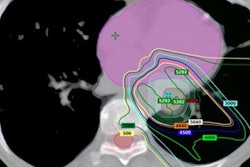
VIENNA - To save time and spare melanoma patients from additional radiation exposure, researchers are recommending that clinicians bypass imaging upper and lower extremities in whole-body FDG-PET/CT scans. The findings were presented on Thursday at ECR 2018.
In a review of more than 1,600 melanoma patients, there were only two cases of a metastasis in an extremity that would not have been detected by a standard skull-to-midthigh PET/CT exam.
"Our data indicated that routine whole-body FDG-PET/CT may not be necessary in all melanoma patients, which would save patients radiation dose, save examination time, and save reporting time," said lead author Dr. Christopher Riedl, PhD, a radiologist at Memorial Sloan Kettering Cancer Center in New York City.
Standard practice
FDG-PET/CT is the modality of choice to evaluate and stage melanoma patients. While the imaging protocol for most cancers covers the standard range from the skull to the midthigh, clinicians usually scan the upper and lower extremities with melanoma patients. This approach has a few disadvantages, however.
"First of all, the scan time increases from 20 to 25 minutes to 30 to 40 minutes," Riedl told ECR attendees. "Secondly, the radiation dose increases with low-dose CT by approximately 0.25 mSv and by approximately 1.5 mSv with diagnostic CT. Finally, with increased scan time, patients start moving and the image quality decreases due to motion artifacts."
Given those less-than-stellar ramifications for patients, why do clinicians still follow the protocol?
"It's because we all learned [that approach] in medical school, and it is a fact that melanoma can metastasize anywhere," Riedl said. "But no one has actually established if there is any medical value in doing whole-body PET/CT for melanoma."
To that end, the researchers began the study by exploring the hospital's database for all melanoma patients who underwent FDG-PET/CT between 2012 and 2017. Imaging reports were analyzed by a computer algorithm seeking descriptions of findings in extremities not included in the standard field-of-view from head to thighs. When there was a finding of potential disease in an extremity, the results were verified by the researchers reading the images to determine if the abnormalities were metastases.
Finally, Riedl and colleagues recorded the location of the metastasis, such as the upper femur; whether the lesion would have been discovered on a skull-to-midthigh FDG-PET/CT scan; and if the patient had disseminated disease.
Lesion evaluation
The researchers found 4,082 whole-body PET/CT scans among 1,654 melanoma patients. Of those scans, 471 (11%) revealed abnormalities in the extremities: 183 (39%) were considered malignant metastases and 181 (38%) were disseminated disease.
Based on the results, only two patients had a metastasis in an extremity that would not have been covered by standard PET/CT or the scan of an extremity afflicted by primary melanoma.
"Clinically relevant metastases in an extremity, which are not the origin of the primary tumor, were identified in 0.05% of the scans in melanoma patients," Riedl concluded. "Whole-body PET/CT almost exclusively detected metastases in the extremities in patients with disseminated disease or in the extremity afflicted by the primary tumor."
Therefore, the recommendation is that upper and lower extremities can be excluded in whole-body FDG-PET/CT scans of melanoma patients with little or no adverse effects, in addition to offering the added benefits of less radiation and scan time.



















